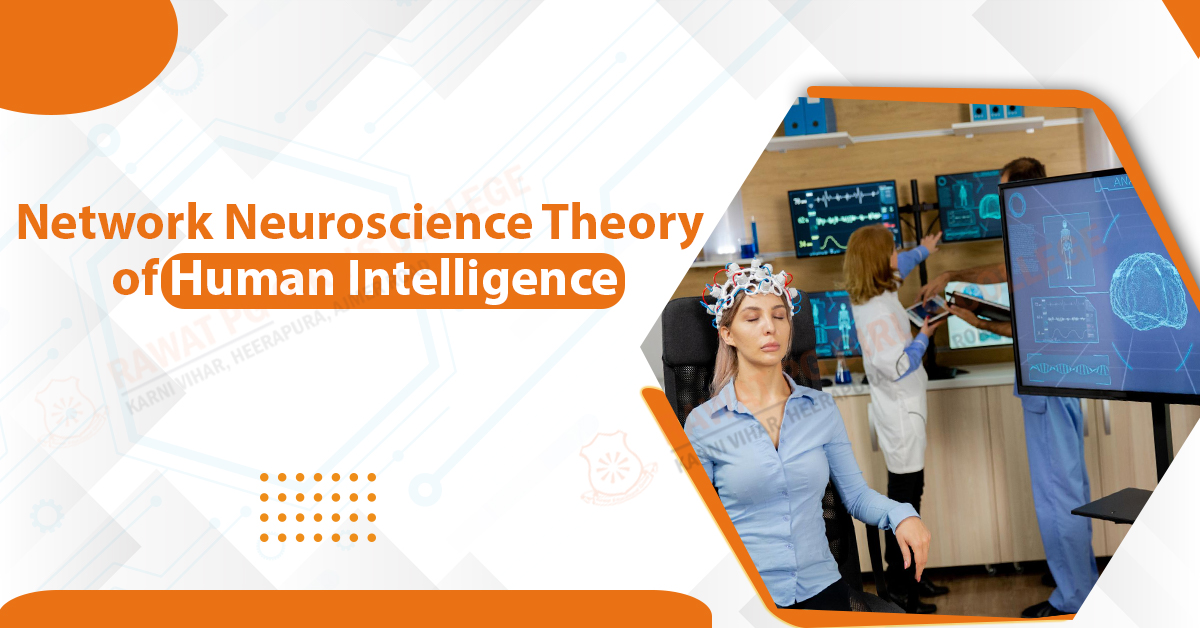Network Neuroscience Theory of Human Intelligence
Network neuroscience is an interdisciplinary field that explores the brain's complex organisation and functioning through the lens of network theory. It recognizes the brain as a dynamic system comprised of interconnected nodes (brain regions) and edges (structural or functional connections) that form intricate networks.
This theoretical framework draws inspiration from graph theory and computational models to analyze and understand the brain's architecture, information processing, and emergent properties.
Researchers can map and quantify the intricate patterns of neural connectivity by leveraging advanced imaging techniques such as functional magnetic resonance imaging (fMRI) and diffusion tensor imaging (DTI). Network neuroscience provides insights into the fundamental principles governing brain dynamics, including how information is transmitted and integrated across regions, the role of network hubs, and the impact of network disruptions on cognition and behaviour.
This approach fosters a holistic understanding of brain function, enabling researchers to unravel the complexities underlying neurological disorders and cognitive processes, ultimately contributing to advancements in neuroscience and clinical applications.
Network Neuroscience Theory of Human Intelligence
The Network Neuroscience Theory of Human Intelligence builds upon the idea that intelligence arises from the intricate interactions and connectivity patterns within the brain's neural network.
It posits that the efficiency and organization of information flow across brain regions, rather than the isolated functioning of specific regions, are crucial for understanding and predicting cognitive abilities. This theory is grounded in the recognition that the brain operates as a highly interconnected network, where the strength and efficiency of connections between different regions influence cognitive processes.
One key aspect of this theory is the concept of functional integration, which refers to the coordination and collaboration among diverse brain regions during cognitive tasks. Functional integration emphasizes the importance of how information is transmitted and processed across the entire network, highlighting the dynamic interactions between regions that contribute to higher-order cognitive functions.
Additionally, the concept of modular organization plays a role, suggesting that the brain comprises specialized modules responsible for specific cognitive functions, and intelligence emerges from the coordinated activity of these modules.
Advanced neuroimaging techniques, such as functional and structural MRI, allow researchers to investigate and map the brain's connectivity patterns. Functional MRI, in particular, reveals the synchronized activation of different brain regions during specific cognitive tasks, providing valuable insights into the network dynamics underlying intelligence. Structural MRI and diffusion tensor imaging (DTI) help map the structural connections, such as white matter tracts, that facilitate communication between brain regions.
The identification of hub regions within the brain is another crucial element of the Network Neuroscience Theory of Human Intelligence. Hubs are nodes with a high degree of connectivity, acting as central points for information transfer within the network. The theory suggests that these hub regions play a pivotal role in integrating information from different brain parts, contributing significantly to overall cognitive performance.
Furthermore, the theory acknowledges the dynamic nature of the brain's network architecture, allowing for adaptability and plasticity in response to learning and experience. This adaptability is reflected in the ability of the brain to reorganize its connections over time, known as neuroplasticity.
Also read: Importance of Girl Education in India
Theories of human intelligence
Several theories attempt to explain the complex and multifaceted nature of human intelligence. Here, I'll delve into some prominent theories in depth:
1. Spearman's Two-Factor Theory:
Charles Spearman proposed a two-factor theory of intelligence in the early 20th century. He suggested that there is a general factor (g) that underlies all cognitive abilities and specific factors (s) that are unique to particular tasks. According to Spearman, individuals who perform well on one type of cognitive task are likely to perform well on others due to the influence of the general factor.
2. Gardner's Multiple Intelligences:
Howard Gardner challenged the notion of a single, general intelligence and proposed a theory of multiple intelligences in the 1980s. Gardner identified several distinct intelligences, including linguistic, logical-mathematical, spatial, musical, bodily-kinesthetic, interpersonal, intrapersonal, and naturalistic intelligences. Each intelligence represents a different way in which individuals excel, and Gardner argued that traditional measures of intelligence often overlook these diverse capabilities.
3. Sternberg's Triarchic Theory:
Robert Sternberg's triarchic theory of intelligence incorporates three facets: analytical intelligence (problem-solving and critical thinking), creative intelligence (novelty and adaptability), and practical intelligence (everyday problem-solving). Sternberg's theory emphasizes that intelligence is not a unitary trait and that individuals may excel in one or more of these areas to varying degrees.
4. Cattell-Horn-Carroll (CHC) Theory:
The CHC theory integrates the contributions of Raymond Cattell, John Horn, and John Carroll. It posits a hierarchical model of intelligence, suggesting that there is a general intelligence factor (g) at the top, broad cognitive abilities in the middle (such as fluid reasoning, crystallized intelligence, memory, and processing speed), and specific narrow abilities at the bottom. This model seeks to provide a comprehensive framework for understanding the structure of cognitive abilities.
5. Fluid and Crystallized Intelligence (Cattell):
Raymond Cattell proposed the distinction between fluid and crystallized intelligence. Fluid intelligence involves the ability to think logically and solve novel problems without relying on previously acquired knowledge. In contrast, crystallized intelligence encompasses knowledge and skills acquired through experience and education. The interplay between these two forms of intelligence contributes to an individual's overall cognitive abilities.
6. Emotional intelligence (Salovey and Mayer, and later popularized by Goleman):
Emotional intelligence involves the ability to perceive, understand, manage, and use emotions effectively in oneself and others. Salovey and Mayer initially introduced this concept, and Daniel Goleman popularized it in the 1990s. Emotional intelligence is seen as a crucial aspect of overall intelligence, impacting interpersonal relationships, decision-making, and personal well-being.
These theories offer diverse perspectives on intelligence, recognizing the multidimensional and context-dependent nature of cognitive abilities. While some emphasize a single, general factor, others highlight the existence of multiple intelligences or specific components that contribute to overall cognitive functioning. The ongoing exploration of intelligence theories contributes to a richer understanding of human cognitive abilities and their implications in various domains of life.



